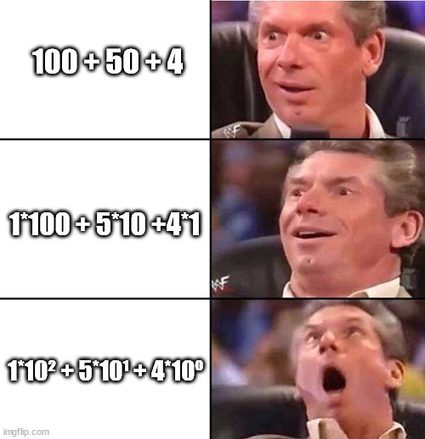How to Write an Equation in Expanded Form
Exponents of 10 are very simple. Whenever we take some integer power of 10 (we're not considering fraction exponents here), the result is the digit 1 with several zeros that corresponds to that power. As we've seen at the end of the above section, the first three positive powers are:
10¹ = 10, 10² = 100, 10³ = 1000,
so the results are the digit 1 with one, two, and three zeros, respectively. On the other hand, the first three negative powers are:
10⁻¹ = 0.1, 10⁻² = 0.01, 10⁻³ = 0.001,
so again, the digit 1 with one, two, and three zeros, respectively, with the slight change that the zeros appear to the left instead of right (that's a result of the minus in the exponent).
Another nice property of powers of 10 is that when we multiply any of them by a one-digit number, the result is the same thing, but with the 1 replaced by that number. For instance:
10 * 5 = 50, 1000 * 3 = 3000, 0.001 * 6 = 0.006,
and these look just like the summands we saw in the expanded notation. In other words, we could exchange every summand when writing numbers in expanded form with a multiplication of something that consists of the digit 1 and some zeros by a one-digit number. And that explains how to write numbers with decimals in expanded form with factors (note how we can choose such an option in the expanded form calculator).
So what does expanded form mean in this case? It again tells us to decompose our numbers into summands corresponding to the digits, but this time, the summands are of the form "digit times a number with 1 and some zeros."
Let's have an example to see it clearly. Recall from the above section that:
154.102 = 100 + 50 + 4 + 0.1 + 0.002.
Using the argument above, we can equivalently write this expanded form example as:
154.102 = 1*100 + 5*10 + 4*1 + 1*0.1 + 2*0.001.
However, we can go even further! Remember how we said at the beginning of this section that all these factors are powers of 10? Well, let's write them as such! This way, we obtain yet another expanded notation: the expanded form with exponents (observe how we can choose this option in the expanded form calculator).
So what is the expanded form with exponents? As before, it's decomposing our number into summands corresponding to the digits, but now the summands take the form "digit times 10 to some power." In this new variant, the above expanded form example looks like this:
154.102 = 1*10² + 5*10¹ + 4*10⁰ + 1*10⁻¹ + 2*10⁻³.
Observe how the powers that appear here agree with the subscripts we used in the second section. Also, note how 1 is also a power of 10, i.e., the zeroth. In fact, any number raised to power 0 equals 1.

All in all, we've managed to learn how to write numbers with decimals in expanded form in three different ways: with numbers, with factors, and with exponents.
In fact, there's only one thing remaining to do: let's finish with describing how to use the expanded form calculator.
How to Write an Equation in Expanded Form
Source: https://www.omnicalculator.com/math/expanded-form
0 Response to "How to Write an Equation in Expanded Form"
Post a Comment